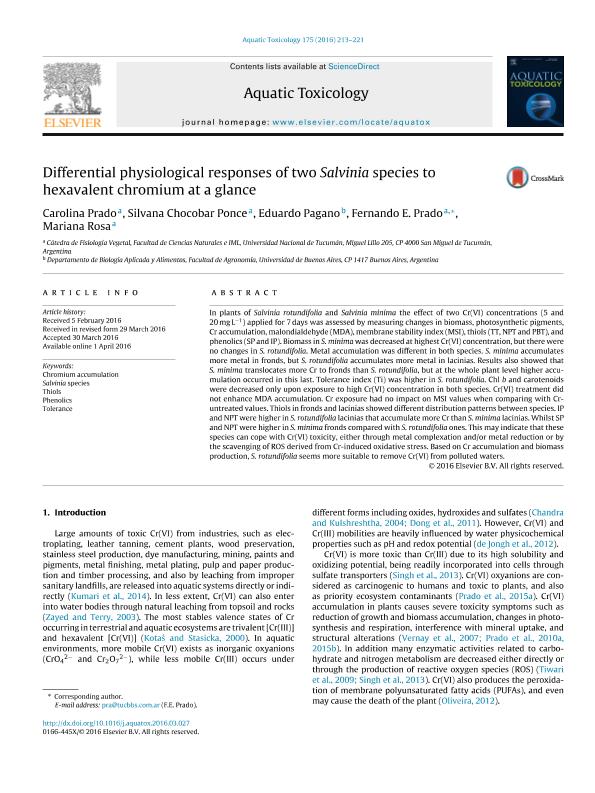Artículo
Differential physiological responses of two Salvinia species to hexavalent chromium at a glance
Prado, Carolina del Valle ; Chocobar Ponce, Silvana
; Chocobar Ponce, Silvana ; Pagano, Eduardo Antonio; Prado, Carolina del Valle
; Pagano, Eduardo Antonio; Prado, Carolina del Valle ; Rosa, Mariana Daniela
; Rosa, Mariana Daniela
 ; Chocobar Ponce, Silvana
; Chocobar Ponce, Silvana ; Pagano, Eduardo Antonio; Prado, Carolina del Valle
; Pagano, Eduardo Antonio; Prado, Carolina del Valle ; Rosa, Mariana Daniela
; Rosa, Mariana Daniela
Fecha de publicación:
06/2016
Editorial:
Elsevier Science
Revista:
Aquatic Toxicology
ISSN:
0166-445X
Idioma:
Inglés
Tipo de recurso:
Artículo publicado
Clasificación temática:
Resumen
In plants of Salvinia rotundifolia and Salvinia minima the effect of two Cr(VI) concentrations (5 and 20 mg L-1) applied for 7 days was assessed by measuring changes in biomass, photosynthetic pigments, Cr accumulation, malondialdehyde (MDA), membrane stability index (MSI), thiols (TT, NPT and PBT), and phenolics (SP and IP). Biomass in S. minima was decreased at highest Cr(VI) concentration, but there were no changes in S. rotundifolia. Metal accumulation was different in both species. S. minima accumulates more metal in fronds, but S. rotundifolia accumulates more metal in lacinias. Results also showed that S. minima translocates more Cr to fronds than S. rotundifolia, but at the whole plant level higher accumulation occurred in this last. Tolerance index (Ti) was higher in S. rotundifolia. Chl b and carotenoids were decreased only upon exposure to high Cr(VI) concentration in both species. Cr(VI) treatment did not enhance MDA accumulation. Cr exposure had no impact on MSI values when comparing with Cr-untreated values. Thiols in fronds and lacinias showed different distribution patterns between species. IP and NPT were higher in S. rotundifolia lacinias that accumulate more Cr than S. minima lacinias. Whilst SP and NPT were higher in S. minima fronds compared with S. rotundifolia ones. This may indicate that these species can cope with Cr(VI) toxicity, either through metal complexation and/or metal reduction or by the scavenging of ROS derived from Cr-induced oxidative stress. Based on Cr accumulation and biomass production, S. rotundifolia seems more suitable to remove Cr(VI) from polluted waters.
Palabras clave:
Chromium Accumulation
,
Phenolics
,
Salvinia Species
,
Thiols
,
Tolerance
Archivos asociados
Licencia
Identificadores
Colecciones
Articulos(CCT - NOA SUR)
Articulos de CTRO.CIENTIFICO TECNOL.CONICET - NOA SUR
Articulos de CTRO.CIENTIFICO TECNOL.CONICET - NOA SUR
Citación
Prado, Carolina del Valle; Chocobar Ponce, Silvana; Pagano, Eduardo Antonio; Prado, Carolina del Valle; Rosa, Mariana Daniela; Differential physiological responses of two Salvinia species to hexavalent chromium at a glance; Elsevier Science; Aquatic Toxicology; 175; 6-2016; 213-221
Compartir
Altmétricas



